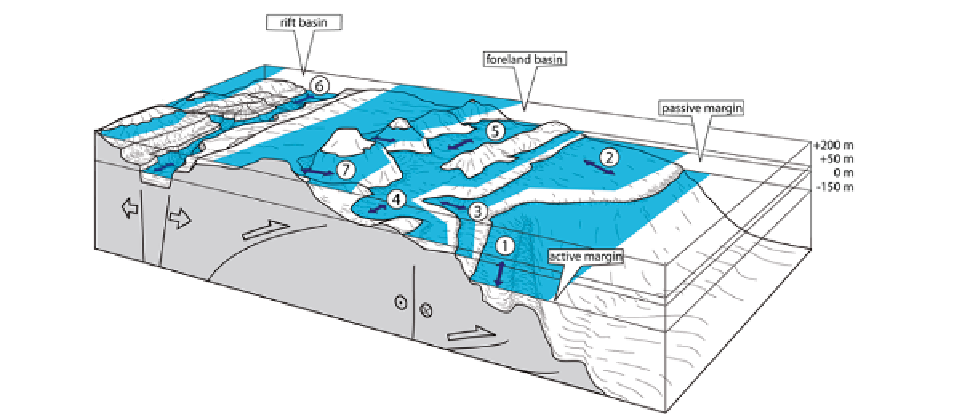Geology Reference
In-Depth Information
Fig. 13.29
Schematic diagram showing the range of tectonic
basin types. In each type, changes in relative sea level cause a
change in basin morphology, which in turn controls where and
when tidal deposits will form. The
arrows
are oriented parallel
to the mean tidal current. The flooding levels displayed corre-
spond to the extremes of long-term (first or second order),
high-amplitude sea-level cycles. Drawing not to scale. Active
and passive margins are displayed as adjacent to each other
only for convenience. Examples:
1
- Te Kuiti Group, New
Zealand, Oligocene (Anastas et al.
1997, 2006
); Hikurangi
fore-arc basin, New Zealand, Pliocene (Kamp et al.
1988
;
Nelson et al.
2003
); Cuyama transform margin, California,
Miocene (e.g. Hoppie
1996
).
2
Celtic Sea, Late Pleistocene
(e.g. Bouysse et al.
1976
); South China Sea, Late Pleistocene
(e.g. Berné et al.
2002
).
3
English Channel, Late Pleistocene to
Holocene (e.g. Reynaud et al.
2003
).
4
Southern North Sea,
Holocene (e.g. Berné et al.
1994
; Trentesaux et al.
1999
);
Yellow Sea, Holocene (e.g. Park et al.
2006
); Greensand
Seaway, Aptian (Yoshida et al.
2004
; Wells et al.
2010
).
5
Perialpine Seaway, Burdigalian (e.g. Lesueur et al.
1988
; Bieg
2005
).
6
North Sea rift basin (Scotland), Jurassic (Blackwood
et al.
2004
; Mellere and Steel
1996
).
7
Bohemian Basin,
Turonian (e.g. Mitchell et al.
2010
). In
1
,
5
,
6
and
7
, the main
control on tidal sedimentation is the constriction of the tidal
flow through a narrow passageway. The tidal range does not
need to be large. In
2
,
3
and
4
, the main control is the increase
in tidal amplitude, related to either an increase in tidal prism
(embayments) and/or tidal resonance (shelf)
result of sea-level rise could bring about an abrupt
decay of tidal currents, as demonstrated by the post-
glacial evolution of Cook Strait, New Zealand (Proctor
and Carter
1989
). As a result of paleotidal modeling
of the Lower Cretaceous Greensands Seaway in
Europe, Wells et al. (
2010
) suggest that, although the
southern connection of the seaway to the Neotethys
would have been crucial for the development of sig-
nificant tides, the existence of a coeval connection to
the North Sea would have caused tides to decrease
(Fig.
13.31
).
During times of very high sea level and extensive
flooding of the continents, extensive, shallow-marine
carbonate sedimentation would occur around emergent
archipelagos. Paleotidal modeling shows that such a
broad, shallow platform would probably be microtidal,
due to the great distance from the open ocean. In such
a setting, strong tidal currents would occur only within
small constrictions between islands, as shown by
modeling of the Bohemian Cretaceous Basin (Mitchell
et al.
2010
), or of the Lower Jurassic Laurasian Seaway
(e.g. Luxembourg sandstones, P. Allison
2010
, per-
sonal communication).
13.9
Summary
The astronomic tide that exists in the deep ocean basin
is amplified as it propagates onto the continental shelf,
and is transformed into a co-oscillating tide by com-
plex interactions with the shallow-water topography.
Particularly pronounced tidal currents occur where
there is tidal resonance in embayments and where there
is local enhancement of tidal currents by a flow con-
striction as in seaways. Tidal currents are efficient in
transporting sediments up to medium-grained sand to

